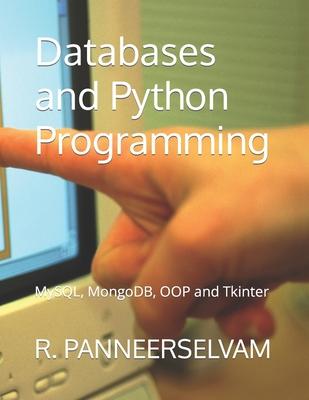
Book
Databases and Python Programming: MySQL, MongoDB, OOP and Tkinter
(Write a Review)
Paperback
$17.00
Based on the feedback received from the learned academic colleagues and students, and also the dynamic changes in the field, I thought it is proper to come out with a book on 'Python programming for Databases: MySQL, MongoDB, Object Oriented Programming (OOP) and tkinter'
This text would be handy in meeting the requirements of business organizations, because Python Programming has three in one feature, viz. high-level language feature, database feature and graphic feature.
This text begins with introduction, which includes need for database, types of decisions and information system, conventional file processing system and database system. The Chapter 2 on database concepts and models presents data and information, metadata, terminologies of file, schema vs subschema, associations between the fields of file, associations between files, one-to-one association between files, data models and entity-relationship model.
It is followed by a chapter on database design, which includes, Top-Down Approach, Bottom-Up Approach and a case study as per bottom-up approach, which uses normalization.
The Chapter 4 on Python MySQL presents Creation of Database, Creation of Table in Python MySQL, Inserting Records in Table 'Student' in Python MySQl, Select Command in MysQL Python, Select .... From ..... Where In MySQL, Adding Field in a Table, Adding Data to New Fields of Table Using Update Command, Select ..... From Order By Query, Delete From ....... Where ...... Command, Drop Table Name of Table Command, Limit, and Limit with Offset Commands, Case study for Limit .. and Limit with Offset Commands, and Join Command. It is followed by a chapter on PYTHON MongoDb, which presents Types of NoSQL Database, Installation, Creation of Database and Collection, Adding First Documet/ Record and Print, Inserting a Set of Documents and Printing Their IDS, Printing Content of Employees Collection, Query to Fetch Fields of Documents Satisfying a Condition, Sorting, Sort Documents of Collection Based on Key and Printing Select Fields, Delete Document(S) of Collection, Drop Collection, Update and Limit() Command.
The Chapter 6 presents Python Object Oriented Programming (OOP), which includes python classes and objects, constructors in python, python destructor, python inheritance, encapsulation, class / static variable and class method and static method. The last chapterb 7 presents tkinter, which includes Tkinter Programming and Tkinter Widgets.
This text is written in easy-to-read style. Each and every chapter contains numerous example programs and in select chapters fitting case studies are presented.
Based on the feedback received from the learned academic colleagues and students, and also the dynamic changes in the field, I thought it is proper to come out with a book on 'Python programming for Databases: MySQL, MongoDB, Object Oriented Programming (OOP) and tkinter'
This text would be handy in meeting the requirements of business organizations, because Python Programming has three in one feature, viz. high-level language feature, database feature and graphic feature.
This text begins with introduction, which includes need for database, types of decisions and information system, conventional file processing system and database system. The Chapter 2 on database concepts and models presents data and information, metadata, terminologies of file, schema vs subschema, associations between the fields of file, associations between files, one-to-one association between files, data models and entity-relationship model.
It is followed by a chapter on database design, which includes, Top-Down Approach, Bottom-Up Approach and a case study as per bottom-up approach, which uses normalization.
The Chapter 4 on Python MySQL presents Creation of Database, Creation of Table in Python MySQL, Inserting Records in Table 'Student' in Python MySQl, Select Command in MysQL Python, Select .... From ..... Where In MySQL, Adding Field in a Table, Adding Data to New Fields of Table Using Update Command, Select ..... From Order By Query, Delete From ....... Where ...... Command, Drop Table Name of Table Command, Limit, and Limit with Offset Commands, Case study for Limit .. and Limit with Offset Commands, and Join Command. It is followed by a chapter on PYTHON MongoDb, which presents Types of NoSQL Database, Installation, Creation of Database and Collection, Adding First Documet/ Record and Print, Inserting a Set of Documents and Printing Their IDS, Printing Content of Employees Collection, Query to Fetch Fields of Documents Satisfying a Condition, Sorting, Sort Documents of Collection Based on Key and Printing Select Fields, Delete Document(S) of Collection, Drop Collection, Update and Limit() Command.
The Chapter 6 presents Python Object Oriented Programming (OOP), which includes python classes and objects, constructors in python, python destructor, python inheritance, encapsulation, class / static variable and class method and static method. The last chapterb 7 presents tkinter, which includes Tkinter Programming and Tkinter Widgets.
This text is written in easy-to-read style. Each and every chapter contains numerous example programs and in select chapters fitting case studies are presented.
Paperback
$17.00